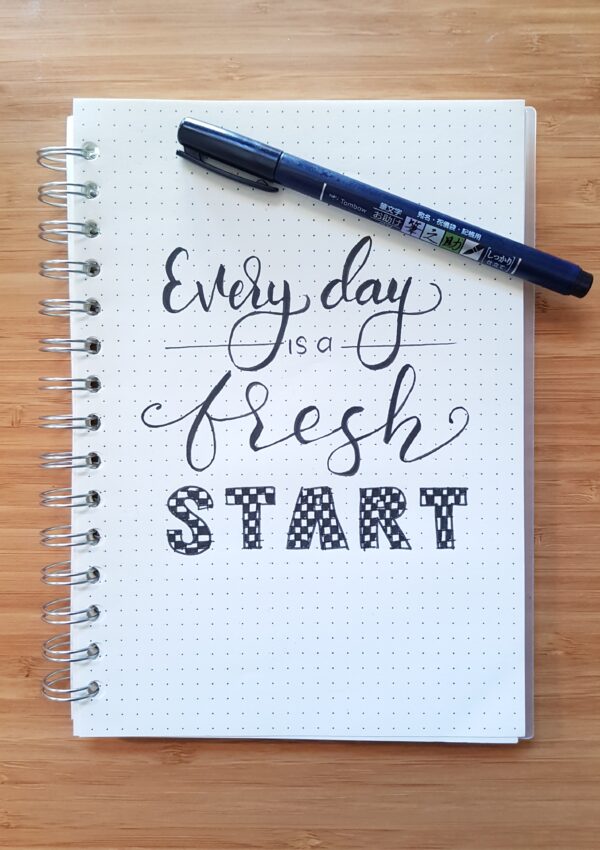Picking up where we left off last week, I’d like to continue down the path of defining what are SMART goals and include some real-life SMART goals examples.
This will do two things. First, it will force me to decide on some of my own SMART goals for 2024. Second, it will give you some ideas about how to set your own SMART goals.
To catch you up, SMART is an acronym that stands for:
- Specific
- Measurable
- Achievable
- Realistic
- Time-Bound
SMART goals must meet all the above-noted criteria. Using this method will weed out the pie-in-the-sky types of goals we are known to slap in a New Year’s list.

SMART Goals Examples
Things like “be a millionaire” or “retire early” are too broad and lofty to be achievable in the span of one year, in most cases. We instead need to focus on action-oriented goals that are within reach, highly specific, and able to be measured.
Some SMART goals examples include:
- Lose 10 pounds in 6 months vs. Get fit
- Write 1 short story a quarter vs. write more fiction
- Write and schedule 4 blog posts in January vs. procrastinate less with blog posts
- Buy a domain name, sign up for hosting, and write 8 blog posts by April vs. start a blog
- Workout 3 days a week vs. get a gym membership
- Put together one cute, fresh outfit a week vs. having a better style
- Save 20% of net income a month vs. saving more money
- Make a $1,000 a month blogging vs. monetize blog
SMART goals need to include a specific time frame, be number-oriented or at least measurable, and be achievable within the allotted time frame. If you feel your cortisol rising, it’s important to note that there are pros and cons to SMART goals.
Pros and Cons of SMART Goals
The positive of setting SMART goals is the fact that you can’t hide behind vague, larger-than-life New Year’s goals that will be forgotten after the first week of January.
The idea that SMART goals must be measurable means you can see exactly where you stand and have an accurate idea of your progress, for better or for worse.
The con of SMART goals is the reality that this style of goal-setting can quickly become legalistic. Sitting down to set SMART goals can feel very rigid, calculated, and not fun in the least.
If you tend to be on the Type-A side of things, it can feel like a threat to your peace to set such specific and measurable goals. Particularly if you are prone to setting too many goals. Regardless if something is achievable, if you have too many goals on your plate, you’ll inevitably be met with failure.
It’s important to remember SMART goals are different from big-picture visions and dreams. There has to be room for both.
Vision Boarding + SMART Goals
Now for some practical steps. Before you sit down to figure out what sort of specific, measurable, achievable, realistic, time-bound goals you want to set out to accomplish in 2024, spend time visionboarding and dreaming. Leaning into the creative side of things will inform the data-driven SMART goals side of things.
Step 1: Create a Vision Board
A vision board is a fun creative way to plan your year. The old-school approach is cutting pictures out of magazines and pinning them to a corkboard. The present-day approach is sitting down in front of Pinterest and pinning photos to a new board for the year.
Step one of how to set SMART goals is to grab a warm drink, create a new board on Pinterest, and start pinning photos that represent the kind of year you want to have. A vision board is a place for visual inspiration for the year.
Take a step back from your board and jot down the themes that come to mind. Try to capture the essence of the images you find yourself gravitating towards. These notes and themes will be the basis of your SMART goals.
Step 2: Create SMART Goals Based on Your Vision Board
The vision boarding process is the process of dreaming and looking forward. It’s important to use the creative outlet of vision boarding in tandem with the uber-structured approach of setting SMART goals. Otherwise, the data-driven goals can suck the fun out of the planning process.
Step two of how to set SMART goals is to review the themes captured and noted from your vision board and break those things down into bite-sized, measurable steps.
When setting SMART goals, focus on setting goals for the first quarter of the year instead of the entire year at once. This approach gives you a built-in timeline when you can check in and audit how you’re doing with reaching your goals at the end of a quarter. This approach will allow you to make adjustments along the way.
Step 3: Be Intentional with Your SMART Goals and Adjust Accordingly
Don’t get too carried away with setting too many goals. Lean into choosing achievable activities. If you’re anything like me, this may look like writing out your list and cutting out at least 30% – 50% of the goals on the list.
Take a look at your current routine and habits. Your goals should be recognizable to those routines, but a little more intentional and developed. The reality is, that we won’t be able to change our lives by simply throwing a list of goals on a sheet of paper or Word document and making them measurable.
Give yourself credit, but not too much credit. Aim to set goals that are within reach so you can stay encouraged and see that you are repeatedly hitting your mark. The fact that you will know if you’re hitting your SMART goals or not due to the measurability of them also gives you the freedom to adjust where needed along the way.
Goals are meant to serve you, not the other way around.
My SMART Goals for 2024
Here are a few of my goals for 2024 and my attempt to frame them in the SMART method.
I’ve organized them into the main categories that we discussed last post.
- Save at least 20% of my net check each month
- Read my Bible every day for 15 minutes
- Call my family members once a month
- Workout / be active 3 times a week (active = hitting Zone 2 or higher for at least 30-minute increments)
- Create a new RFP for a new group at work
- Write and schedule four blog posts to stay ahead of my blog content
- Drink a gallon of water a day
Well, here’s my attempt at setting some SMART goals. I could certainly use a little more detail with each and some refining. It will help when I sit down to create my Vision board. I’ll come back and add and take away as needed.
The important thing to remember is goals are meant to serve you, not the other way around. Personally, I really enjoy to-do lists and data-driven living but have been known to take it too far and end up more frustrated than productive.
Lowering expectations to reasonable objectives that fit within your current life is key. Envisioning a completely different life and setting goals accordingly is where things can get tricky.




